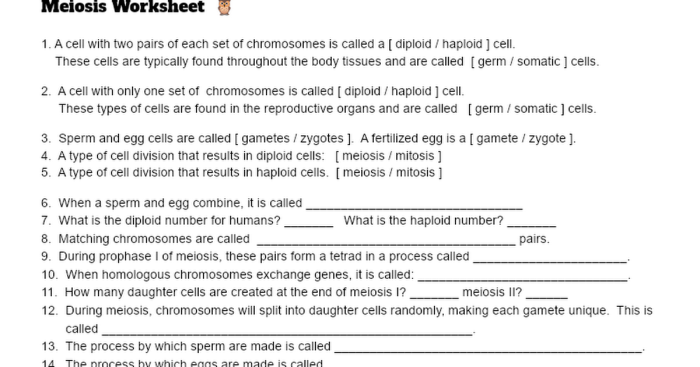Welcome to the Mitosis and Meiosis Review Worksheet, an indispensable resource for students seeking to master the intricacies of cell division. This comprehensive guide will provide a thorough overview of both mitosis and meiosis, equipping you with a deep understanding of their processes, significance, and applications.
Throughout this worksheet, we will delve into the stages of mitosis and meiosis, exploring their key differences and the role they play in growth, repair, sexual reproduction, and genetic diversity. Engaging practice problems and real-world examples will reinforce your understanding and prepare you for success in your studies.
Mitosis Overview

Mitosis is a type of cell division that produces two identical daughter cells from a single parent cell. It is a continuous process, but it can be divided into four distinct stages: prophase, metaphase, anaphase, and telophase.Mitosis is essential for the growth and development of multicellular organisms.
It allows for the replacement of old or damaged cells and the production of new cells for growth and repair.
Stages of Mitosis
Prophase* The chromosomes become visible and the nuclear envelope begins to break down.
The centrosomes, which are responsible for organizing the spindle fibers, begin to move to opposite poles of the cell.
Metaphase* The chromosomes line up in the center of the cell.
The spindle fibers attach to the chromosomes and begin to pull them apart.
Anaphase* The chromosomes continue to be pulled apart by the spindle fibers.
The chromosomes reach opposite poles of the cell.
Telophase* The spindle fibers disappear and the nuclear envelope reforms around each of the two daughter cells.
The chromosomes become less visible and the cell begins to divide into two individual cells.
Purpose and Outcome of Mitosis
The purpose of mitosis is to produce two identical daughter cells from a single parent cell. This is essential for the growth and development of multicellular organisms. Mitosis also plays a role in tissue repair and replacement.The outcome of mitosis is two daughter cells that are genetically identical to the parent cell.
This is important because it ensures that the new cells have the same genetic information as the old cells.
Comparison of Mitosis and Meiosis
Mitosis and meiosis are two distinct types of cell division that play vital roles in the life cycle of eukaryotes. While both processes involve the division of the cell, they differ significantly in their outcomes and purposes.
The following table provides a comprehensive comparison of the key characteristics of mitosis and meiosis:
Comparison Table
| Characteristic | Mitosis | Meiosis |
|---|---|---|
| Number of cell divisions | One | Two |
| Chromosome number | Maintained (diploid, 2n) | Reduced by half (haploid, n) |
| Purpose | Growth, repair, and asexual reproduction | Sexual reproduction |
Mitosis and Meiosis Practice Problems: Mitosis And Meiosis Review Worksheet
Stage Identification
Identify the stage of mitosis or meiosis based on the following descriptions:
- Chromosomes are condensed and aligned at the equator of the cell.
- Nuclear envelope is breaking down and chromosomes are becoming visible.
- Chromatids are separating and moving to opposite poles of the cell.
- Homologous chromosomes are pairing up.
- Tetrads of chromosomes are formed.
Chromosome Number
Determine the number of chromosomes in the following cells:
- A somatic cell in a human with 46 chromosomes.
- A gamete in a human with 23 chromosomes.
- A cell in prophase I of meiosis in a fruit fly with 8 chromosomes.
- A cell in anaphase II of meiosis in a plant with 12 chromosomes.
Genetic Implications
Explain the genetic implications of the following processes:
- Crossing over during meiosis.
- Independent assortment of chromosomes during meiosis.
- Non-disjunction during mitosis.
- Non-disjunction during meiosis.
Applications of Mitosis and Meiosis
Mitosis and meiosis are fundamental processes in the life cycle of eukaryotic organisms. They play crucial roles in various aspects of growth, development, and genetic diversity.
Applications of Mitosis, Mitosis and meiosis review worksheet
Mitosis, the process of cell division that results in two genetically identical daughter cells, has numerous practical applications:
- Growth and Repair:Mitosis is essential for the growth and development of multicellular organisms. It allows for the increase in cell number, resulting in the formation of new tissues and organs. Additionally, mitosis plays a vital role in tissue repair by replacing damaged or lost cells.
- Cloning:Mitosis is the basis for cloning, a process that involves creating genetically identical copies of an organism. This technique has applications in agriculture, medicine, and conservation efforts.
Significance of Meiosis
Meiosis, the process of cell division that results in four genetically distinct gametes (eggs or sperm), is of utmost importance for genetic diversity and evolution:
- Genetic Diversity:Meiosis ensures genetic diversity by randomly assorting chromosomes during cell division. This process creates gametes with unique combinations of alleles, leading to a wide range of genetic variations within a population.
- Evolution:Genetic diversity is the raw material for evolution. The variations introduced by meiosis allow for natural selection to act upon different traits, favoring those that enhance an organism’s survival and reproductive success in a given environment.
Answers to Common Questions
What is the main difference between mitosis and meiosis?
Mitosis produces two identical daughter cells, while meiosis produces four genetically diverse daughter cells.
What is the significance of mitosis?
Mitosis is essential for growth, repair, and asexual reproduction.
What is the role of meiosis in sexual reproduction?
Meiosis ensures genetic diversity by creating gametes with half the number of chromosomes as the parent cells.